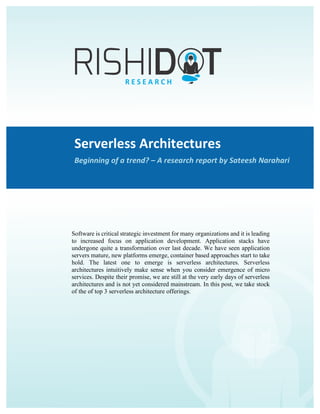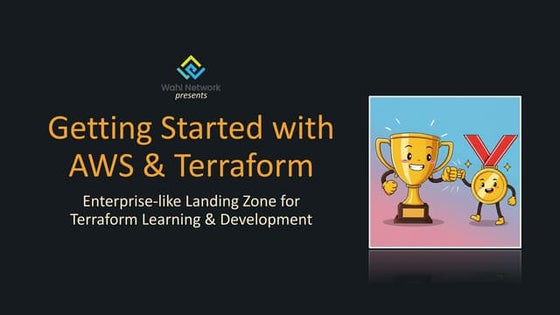Serverless Architecture - Beginning of a Trend?
- 1. Serverless Architectures ©C Beginning of a trend? A Rishidot Research Report by Sateesh Narahari Serverless Architectures Beginning of a trend? ©C A research report by Sateesh Narahari Software is critical strategic investment for many organizations and it is leading to increased focus on application development. Application stacks have undergone quite a transformation over last decade. We have seen application servers mature, new platforms emerge, container based approaches start to take hold. The latest one to emerge is serverless architectures. Serverless architectures intuitively make sense when you consider emergence of micro services. Despite their promise, we are still at the very early days of serverless architectures and is not yet considered mainstream. In this post, we take stock of the of top 3 serverless architecture offerings.
- 2. Serverless Architectures ©C Beginning of a trend? A Rishidot Research Report by Sateesh Narahari Introduction Amazon's Tim Wagner has a good brief description of what serverless architectures mean: "By Ī░serverlessĪ▒, we mean no explicit infrastructure required, as in: no servers, no deployments onto servers, no installed software of any kind" This may be the most exciting new architectural approach in recent times, and it will transform how applications are developed in the future. We have considered 3 distinct options: Firebase (owned by Google), Parse (owned by Facebook and recently shut down) and Lambda (owned by Amazon Web services). We found that the adoption of serverless architectures has been slow so far and it is an early indication of the difficulties that face vendors such as AWS to achieve higher adoption. Firebase (owned by Google) Started by: Andrew Lee (http://twitter.com/startupandrew ), James Tamplin (http://twitter.com/jamestamplin ) Tweets over time: Why Tweets: Tweets can be a rough estimate of how a particular topic is trending among geeks. While tweets do not capture full population, itĪ»s a data point. From 1/1/2013 ©C 9/1/2015 0 500 1000 1500 2000 2500 3000 3500 FireBase Tweets over time
- 3. Serverless Architectures ©C Beginning of a trend? A Rishidot Research Report by Sateesh Narahari As we can see there were two spikes in tweets, and both dates involve an acquisition. On Oct 21, 2014, Google acquired Firebase. Almost a year later, Google acquired web-hosting company Divshot and merged it with Firebase team. Google Trends on Firebase over time: As we can see there is a steady but slow increase in Google searches, with a spike in 2014 when Google acquired Firebase. However the number of searches per day is still low. Top regions for Firebase Google searches are: United States: 100 Canada: 97 Australia: 87 India: 63 United Kingdom: 59 France: 34 Germany: 34 Brazil: 28 Parse (owned by Facebook and retired by Facebook on 1/28/2016) Founded by: Ilya Sukhar, James Yu, Kevin Lacker, Tikhon Bernstam Tweets over time: 0 20 40 60 80 100 120 Firebase Google Trends
- 4. Serverless Architectures ©C Beginning of a trend? A Rishidot Research Report by Sateesh Narahari Facebook acquired Parse on Apr 25, 2013 and we see a spike in tweets on Apr 26, 2013. The second short spike was on Apr 30, 2014 when Facebook dropped pricing on Parse, added offline capabilities. The third spike was on Mar 26, 2015 when Parse announced an SDK for Internet of Things. The third shorter spike happened in August of 2015 when Parse had open sourced all of its SDKs. LetĪ»s look at Google trends for Parse: We see that the Google trends for Parse is trending upwards slowly and steadily. 0 50 100 150 200 250 300 Parse Tweets 0 20 40 60 80 100 120 2013-01-06 -2013-ĪŁ 2013-02-17 -2013-ĪŁ 2013-03-31 -2013-ĪŁ 2013-05-12 -2013-ĪŁ 2013-06-23 -2013-ĪŁ 2013-08-04 -2013-ĪŁ 2013-09-15 -2013-ĪŁ 2013-10-27 -2013-ĪŁ 2013-12-08 -2013-ĪŁ 2014-01-19 -2014-ĪŁ 2014-03-02 -2014-ĪŁ 2014-04-13 -2014-ĪŁ 2014-05-25 -2014-ĪŁ 2014-07-06 -2014-ĪŁ 2014-08-17 -2014-ĪŁ 2014-09-28 -2014-ĪŁ 2014-11-09 -2014-ĪŁ 2014-12-21 -2014-ĪŁ 2015-02-01 -2015-ĪŁ 2015-03-15 -2015-ĪŁ 2015-04-26 -2015-ĪŁ 2015-06-07 -2015-ĪŁ 2015-07-19 -2015-ĪŁ 2015-08-30 -2015-ĪŁ 2015-10-11 -2015-ĪŁ 2015-11-22 -2015-ĪŁ 2016-01-03 -2016-ĪŁ Parse Google Trends
- 5. Serverless Architectures ©C Beginning of a trend? A Rishidot Research Report by Sateesh Narahari Top regions for Google searches for Parse are: India 100 United States 38 AWS Lambda Even though AWS Lambda was only introduced in late 2014, it has managed to capture the attention of technology analysts and developers. Twitter trends for AWS Lambda: AWS has done a good job of keeping the interest steady since becoming available for production in Apr 2015. They have kept up the buzz by featuring early adopters and use cases at various AWS events. However, the second biggest peak in mentions is at the 2015 re:invent conference. Google trends for AWS shows a steady increase over time: 0 100 200 300 400 500 600 700 800 AWS Lambda Tweets
- 6. Serverless Architectures ©C Beginning of a trend? A Rishidot Research Report by Sateesh Narahari Top regions for AWS Lambda are: United States. If you look at the volume of Tweets and Google trends, Google acquiring Firebase led to the most discussion/tweets, but then the volume tapered off. Overall, AWS Lambda is leading in terms of awareness, but the trends show that its volumes are still low. While just looking at tweet volumes and Google trends does not portray a complete picture of projects that leverage these serverless architectures, itĪ»s safe to say that serverless architectures are not mainstream yet. Serverless architecture is still in its infancy. Parse and Firebase have been around for more than 2 years, but not widely used or discussed. It should come as no surprise to us by looking at the data that Facebook did not see much future for Parse in their developer stream. Given current trends, it would have required lot more investment and push from Facebook to keep Parse going. I do believe that Google Firebase faces similar risk, however, given GoogleĪ»s strategic investment into becoming a serious cloud infrastructure contender, they may continue investing in Firebase in the near future. Keep in mind that, Google is known for being cut throat when a product or a feature does not meet its internal growth rates (ex: Google Reader). Caution is in order for organizations considering to use Firebase at this early stage. AWS Lambda is approximately 1 year old and it is generating some early interest and a few interesting projects, however the adoption of it has been slower. 0 20 40 60 80 100 120 2013-01-06 -2013-ĪŁ 2013-02-17 -2013-ĪŁ 2013-03-31 -2013-ĪŁ 2013-05-12 -2013-ĪŁ 2013-06-23 -2013-ĪŁ 2013-08-04 -2013-ĪŁ 2013-09-15 -2013-ĪŁ 2013-10-27 -2013-ĪŁ 2013-12-08 -2013-ĪŁ 2014-01-19 -2014-ĪŁ 2014-03-02 -2014-ĪŁ 2014-04-13 -2014-ĪŁ 2014-05-25 -2014-ĪŁ 2014-07-06 -2014-ĪŁ 2014-08-17 -2014-ĪŁ 2014-09-28 -2014-ĪŁ 2014-11-09 -2014-ĪŁ 2014-12-21 -2014-ĪŁ 2015-02-01 -2015-ĪŁ 2015-03-15 -2015-ĪŁ 2015-04-26 -2015-ĪŁ 2015-06-07 -2015-ĪŁ 2015-07-19 -2015-ĪŁ 2015-08-30 -2015-ĪŁ 2015-10-11 -2015-ĪŁ 2015-11-22 -2015-ĪŁ 2016-01-03 -2016-ĪŁ AWS Lambda Google Trends
- 7. Serverless Architectures ©C Beginning of a trend? A Rishidot Research Report by Sateesh Narahari Serverless architectures promise several benefits, but requires a shift in thinking. This won't happen that easily unless we see other CSPs begin supporting them What are some potential reasons for slow uptake? - New programming model - Lack of dev toolset integration - Immaturity surrounding operational practices ©C itĪ»s an unknown for operation teams in larger projects. - Fears of lock-in - Difficult to understand cost structure - Limited support for different languages What can vendors do to increase the adoption? - Education - Engage large customers to adopt it broadly - Target larger developer audience - Invest in Dev and Ops tool integrations AuthorĪ»s Note: A word of caution: we looked at only publicly available data and havenĪ»t parsed through several use cases. This shall only be taken as baselining about serverless architectures as of early 2016 and not a definitive summary of the state of serverless architectures. We looked at the twitter data till Q3, 2015 and did not account for Q4 activity as Apple has shut down the tool we were using (Topsy). We do not believe that Q4 activity would significantly change the trend for Parse and Firebase. However, due to AWS ReInvent in Oct 2015 and few customer use cases published for AWS Lambda, this data can be considered incomplete, however it is our subjective assessment that it does not significantly change our conclusion about current state of serverless architectures. Author Bio: Sateesh Narahari, Senior Research Advisor Sateesh Narahari is a well respected expert on cloud infrastructure and security. He is a strong advocate of public cloud services as organizations transform into modern enterprise. Sateesh currently works with a stealth cloud security software company based in Boulder, CO leading their product and engineering teams. Previously, Sateesh worked with Ping Identity, MuleSoft, Symantec and Wily. Sateesh focuses on building new products in emerging markets and is a keen student of innovatorĪ»s dilemma, having watched it unfold across many companies. Sateesh earned a B.Tech (Computer Science) from National Institute of Technology, India and an MS (Computer Science) from University of Colorado, USA Research Focus Areas: Application development, Security and Cloud infrastructure

































































